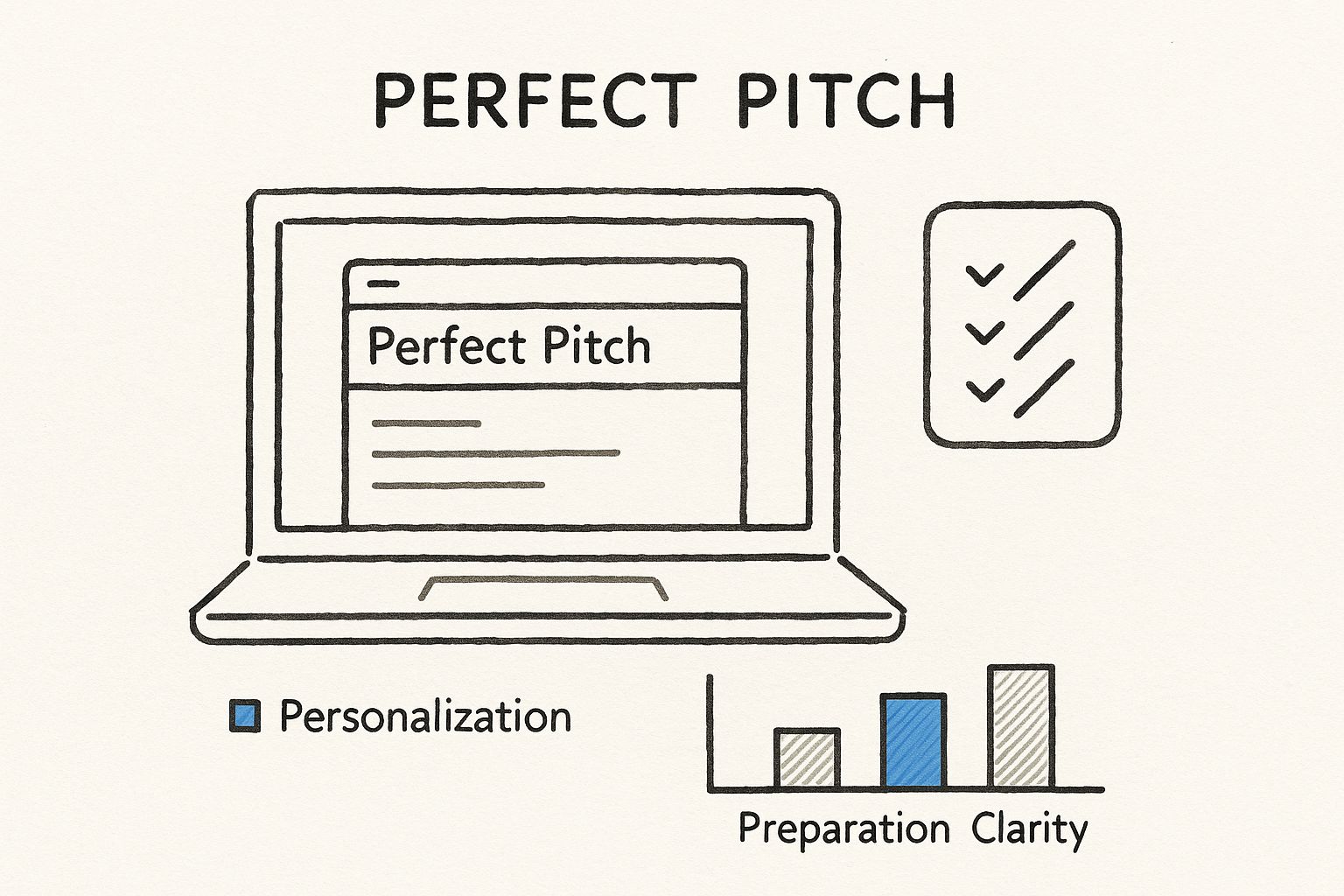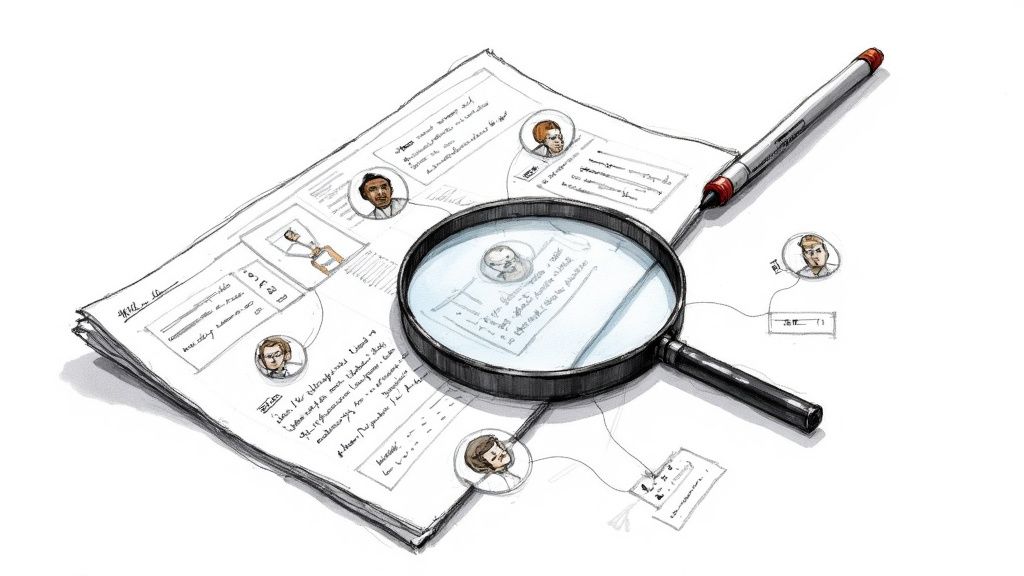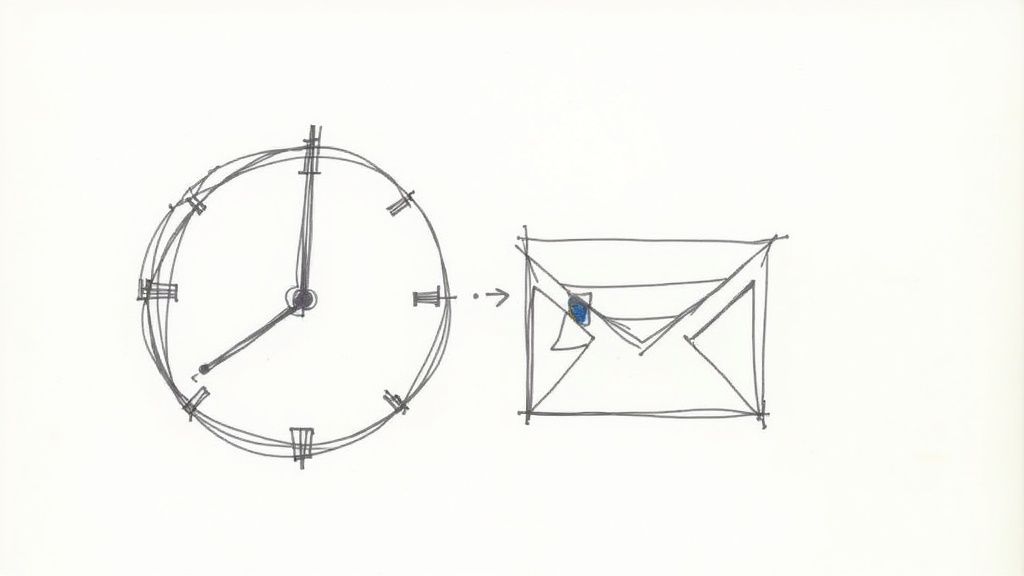A Guide to Pitching to Media That Gets a Yes
October 2, 2025

Pitching the media isn't about blasting out a press release and hoping for the best. It's the art of turning what you find interesting about your company into a story that a journalist needs to tell their audience. It all comes down to finding the right reporter, crafting a message that resonates with them personally, and building a real relationship. Your goal is to be a valuable source, not just another piece of promotional noise in their inbox.
Build Your Foundation for a Winning Media Pitch
Before you even dream of hitting "send" on an email, you have to lay the groundwork. A successful pitch starts with a solid strategy, long before you write a single word. This is where you move beyond a simple announcement and start building a narrative that can actually capture a journalist's attention.
The first, most crucial step is figuring out what makes your story genuinely newsworthy. Journalists aren't an extension of your marketing department; they're gatekeepers for their readers. You have to ask the tough questions: Why should anyone outside of my company care about this? Does it tie into a bigger industry trend? Does it offer a surprising new solution to a widespread problem? The answer to these questions is the bedrock of your entire pitch.
Define Your Core Narrative and Goals
A strong, clear narrative is your guide. What's the real story here? Is it a disruptive new product, a major company milestone, or an expert insight that challenges conventional wisdom? Frame it like a headline, not a feature list. For example, "We launched a new app" is forgettable. "New App Cuts Small Business Accounting Time by 50%, Tackling a Major Burnout Contributor" is a story.
Just as important is knowing what you want to achieve. What does a "win" actually look like for this campaign?
- Brand Awareness: Getting a feature story in a top-tier national publication.
- SEO & Authority: Earning a valuable backlink from a high-authority industry blog.
- Lead Generation: Driving qualified traffic from an in-depth article in a niche trade journal.
Having a specific goal helps you focus your efforts, target the right publications, and shape your angle. This clarity is essential for understanding what is media outreach and how to measure its impact on your business.
“The key is to think like a reporter. They aren't interested in your product; they are interested in a story that will captivate their readers. Your job is to connect the dots for them.”
Understanding the Modern Media Environment
The media world looks nothing like it did a decade ago. It’s not just about print magazines and the evening news anymore. Today’s journalists are often multi-platform creators, juggling blogs, podcasts, social media, and video channels all at once.
This shift means your pitching strategy has to be more sophisticated. You need to understand each platform and its unique audience. A dense, text-heavy press release is useless to a YouTuber, while a story perfect for a podcast needs a compelling audio hook. Tailoring your pitch to the journalist’s preferred medium—and including assets like high-res images or video clips—is no longer a nice-to-have. It’s absolutely critical to stand out.
Create a Hyper-Targeted Journalist List
Even the most brilliant pitch is just spam if it lands in the wrong inbox. The single most important shift you can make in your media outreach is to ditch the old "spray and pray" method. Building a hyper-targeted journalist list is all about quality over quantity—making sure every single person you contact is a genuine fit for your story.
Think of it as professional matchmaking. Your job is to find journalists who don't just cover your industry but are actively interested in the specific angle you're pitching. Sending a FinTech app announcement to a reporter who only writes about enterprise SaaS is a complete waste of everyone's time.
Finding the Right Contacts
I always start by looking for reporters who have recently written about competitors, key industry trends, or topics that overlap with my story. You can get surprisingly far with advanced Google searches. For instance, a query like site:forbes.com "healthtech funding" OR "digital health" will immediately pull up relevant articles and, more importantly, the authors who wrote them.
LinkedIn has also become an absolute goldmine. It's now the top social platform for journalists, making it an essential place to build professional connections. You can follow reporters, see what they're sharing, and get a real sense of their focus long before you ever hit "send" on an email.
Vetting Your List for Relevance
Once you have a starting list of names, the real work begins. You have to vet every single contact. This isn't just about glancing at a job title; it's about digging into their work to truly understand what makes them tick.
This visual guide breaks down what it takes to get a pitch noticed.

As the graphic shows, a great pitch is built on a foundation of solid research and personalization, not just a clever subject line. Before you add anyone to your final list, run them through a quick mental checklist:
- What's their beat? Go read their last five articles. Are there specific themes, companies, or technologies they keep coming back to?
- Who are they writing for? Is their audience made up of C-suite executives, hardcore techies, or the general public? Your story needs to resonate with those readers.
- What's their writing style? Is it deeply analytical and packed with data, or do they lean toward narrative, human-interest stories? Your pitch should mirror that tone.
Taking the time to properly vet your list is crucial for building a list that actually gets results. Here is a simple checklist you can use to make sure every contact is a good fit.
Journalist Vetting Checklist
| Vetting Criteria | What to Look For | Why It Matters |
|---|---|---|
| Beat Alignment | Read their last 5-10 articles. Do they cover your specific topic or industry? | This is the most basic filter. A pitch outside their beat is an instant delete. |
| Recent Activity | When was their last article published? Are they actively writing on this topic now? | An old article from two years ago doesn't mean they're still interested. |
| Audience Relevance | Who reads their work? (e.g., B2B execs, consumers, developers) | Your story must provide value to their specific audience, not just yours. |
| Angle Preference | Do they prefer data-driven reports, founder interviews, or trend pieces? | Matching your pitch angle to their preferred story format dramatically increases your odds. |
| Social Media Presence | What are they talking about on LinkedIn or X? | This gives you clues about their current interests and can provide a great personalization hook. |
This systematic vetting process ensures you're not just guessing but making informed decisions about who to contact.
A journalist’s inbox is a crowded, unforgiving place. A pitch that’s even slightly off-topic isn’t just ignored—it actively damages your credibility for any future outreach. Proving you’ve done your homework is your ticket to being taken seriously.
This isn't just a hunch; the data backs it up. Recent studies show that a staggering 86% of journalists will immediately reject pitches that don't align with their beat. What's more, 47% say they rarely receive relevant pitches, which points to a massive opportunity for anyone willing to do the work. You can explore more insights about PR trends to see what journalists are looking for right now. This level of precision turns a simple spreadsheet into a powerful strategic asset for any media outreach campaign.
Craft a Pitch Email That Journalists Actually Read

You’ve done the research and built your list. Now comes the moment of truth: writing the actual email. This is your one real chance to slice through the chaos of a journalist's inbox, so every single word matters. It all starts with the most important part—the subject line.
Think of your subject line as your digital handshake. It has to be compelling enough to earn a click but professional enough to be taken seriously. Get rid of vague, lazy phrases like "Story Idea" or "Press Release." A killer subject line is a mini-headline that screams value from the get-go.
Put yourself in their shoes for a second. They're scanning dozens, if not hundreds, of emails. A subject line that's specific and intriguing is a lifeline. Instead of something generic like "New App Launch," try this: "Exclusive: New FinTech App Slashes SMB Invoicing Time by 40%." See the difference? It instantly tells them what it is, who it's for, and why they should care.
Structure Your Pitch for Readability
Once they open your email, the clock is ticking. You have just a few seconds to grab and hold their attention. Journalists prize clarity and brevity above all else. Long, winding paragraphs are a one-way ticket to the trash folder.
Always start with a personalized opening. It’s the easiest way to prove you’ve done your homework. Reference a recent article they wrote or a topic they’re passionate about on Twitter. This small touch shows you see them as a person, not just another contact on a spreadsheet.
A simple, powerful structure I've seen work time and again looks like this:
- The Hook: A single, personalized sentence to start.
- The Core Value: Two or three sentences explaining your story and why it's a perfect fit for their audience.
- The Proof: A few punchy bullet points with key data, a surprising statistic, or a strong quote.
- The Ask: A clear, easy-to-act-on call to action.
This keeps your pitch scannable and gets straight to the point. The goal is to make it completely effortless for them to see the story's potential.
The Art of the Narrative and the Call to Action
Remember, your pitch isn't just a list of facts—it's a story in miniature. You need to connect the dots for the journalist. Explain how your announcement fits into a bigger, newsworthy trend. Frame your news as a solution to a problem they've covered or as a fresh twist in an ongoing industry conversation.
Let's say you're pitching a new HealthTech platform. Don't just talk about features. Link it to the massive shift toward remote patient care. This gives your pitch context and elevates it from a simple product launch to a story that's truly relevant.
Your pitch email should feel less like a sales letter and more like a confidential tip from a trusted source. Provide undeniable value, make a clear connection to their work, and then get out of the way.
Finally, you need to stick the landing with a clear and easy call to action. Don't be vague with something like, "Let me know what you think." Offer something specific and low-commitment.
- "Are you available for a brief 15-minute chat to discuss the data?"
- "Would you be interested in an exclusive first look at the platform?"
- "I can connect you with our founder for a quick interview."
This makes it incredibly easy for them to say "yes." If you want more inspiration, you can learn a ton by studying successful email pitches examples and seeing what makes them tick. By focusing on value, clarity, and a personal touch, you’ll start crafting pitches that journalists actually want to read and, more importantly, act on.
Use Technology and AI for Smarter Media Outreach

Let's be real: modern media outreach is a balancing act. You need authentic, human connection to stand out, but you also need the efficiency that technology brings to the table. If you ignore the tools available, you're just making your job harder. The trick is to use tech to superpower your workflow, not to outsource the relationship-building that actually gets you press.
Think of Generative AI as a brilliant, lightning-fast brainstorming partner. It's fantastic for getting the ball rolling. You can use it to explore different story angles, find industry trends that tie into your news, or even get a rough draft of a pitch on the page. This handles some of the initial grunt work, giving you more time and brainpower to focus on strategy and genuine personalization.
AI as an Assistant, Not an Author
The fastest way to get your email deleted is to let AI write and send your pitches without a heavy dose of human oversight. It's an assistant, not a publicist. Your industry knowledge, your unique voice, and your ability to make a real connection with a journalist are still your most valuable assets. Don't let a robot get in the way of that.
Here are a few smart ways to put AI to work:
- Brainstorming Angles: Give it your core announcement and ask for five different news hooks, maybe one for a business audience, one for tech press, and one for consumer lifestyle.
- Whipping Up Subject Lines: Ask it to generate ten or fifteen subject line ideas. You probably won't use any of them verbatim, but you can cherry-pick the strongest words and phrases to build your own killer subject line.
- Quick Personalization Research: Have AI quickly summarize a journalist’s last few articles. This is a great shortcut to finding common themes you can reference in your opening line.
Navigating the Risks and Realities
While AI can be a huge help, you have to remember that journalists are, understandably, a bit wary. The media world is changing fast. While more than half of journalists are now using AI themselves, a whopping 72% are concerned about the factual accuracy of AI-generated content from PR pros.
This means you have to be extra diligent. Transparency and obsessive fact-checking are non-negotiable. For a deeper dive into how journalists are adapting, check out Cision's 2025 State of the Media report. Anything you create with AI's help needs a thorough review for accuracy and tone before it ever leaves your outbox.
When you use AI, your job title changes from writer to editor-in-chief. You are the final gut check, and it's on you to make sure the pitch is accurate, authentic, and actually valuable to the person receiving it.
Beyond just AI, dedicated PR platforms are essential for keeping your outreach organized and effective. Media monitoring and contact management tools aren't just nice-to-haves anymore; they're what give you an edge. If you're looking to take the administrative busywork off your plate, exploring some of the top PR automation tools is a great next step. They let you focus on what really matters: telling a great story.
Master the Follow-Up and Build Real Relationships
Hitting "send" on your pitch feels great, but let's be honest—that's only half the job. What you do next often separates a story that gets picked up from one that vanishes into the digital ether. Silence from a journalist rarely means "no." It almost always means "I have 300 other emails just like yours."
The real art is being persistent without being a pest. It's a delicate dance. You want to give your email a gentle nudge back to the top of their inbox, not badger them for a reply.
The Gentle Nudge: How to Follow Up The Right Way
A single, polite follow-up is pretty standard in the PR world. My rule of thumb? Wait at least 3 to 5 business days before you even think about reaching out again. This gives them a chance to actually see your first email. Any sooner, and you come across as desperate. Any later, and your story might already be old news.
The biggest mistake I see people make is sending a follow-up that just says, "Hey, just checking in on this." That’s a waste of everyone's time. Your goal is to add something new to the conversation, not just ask if they read your last email.
Think about what else you can offer. Did new data just come out that supports your story? Did a competitor just make a move that makes your angle even more relevant? Lead with that.
Here's a simple way to frame it that's worked well for me:
- Subject: Re: [Your Original Subject Line]
- Body: "Hi [Journalist Name], quick follow-up here. Since I reached out, our data was actually featured by [Industry Leader], which really underscores its relevance to [Their Beat]. Let me know if you'd like to chat."
This little addition does two things: it shows you’re respectful of their time and it subtly adds more credibility to your original pitch.
Navigating the follow-up process can be tricky, as you don't want to come across as pushy. Here's a simple framework I use to keep my follow-ups timely and valuable without overstepping.
Follow-Up Timing and Content Strategy
| Follow-Up Number | Timing | Message Focus |
|---|---|---|
| 1 | 3-5 business days after initial pitch | Add a small piece of new information (e.g., a new data point, a relevant news hook, or an additional expert source). Keep it brief. |
| 2 | Another 5-7 business days (optional) | Offer a completely different angle on the story. This is a final, "hail mary" attempt and should only be used if you're confident in the story's value. |
After one or two attempts, it's time to read the room. If you still hear crickets after a value-added follow-up, take it as a "not right now." Pestering them beyond this point is the fastest way to get your emails automatically sent to their trash folder. Trust me, you don't want that.
Pitching to media isn't about closing a deal; it's about opening a door. The best public relations professionals understand that a single pitch is just one interaction in a much longer professional relationship.
You’re Playing the Long Game, Not Just Pitching a Story
The most successful people in PR don't just hunt for one-off placements. They focus on building real, long-term relationships. The end goal isn't just getting one story published; it's becoming a trusted resource that reporters want to hear from.
When you achieve that, you're no longer just another pitch. You're a go-to contact.
This means your work isn't over when the pitch is sent. Here’s what you should be doing consistently:
- Engage with their content. Don't just follow them on social media—share their articles and add a thoughtful comment. Show them you’re actually reading their work.
- Be a source, not just a pitcher. Let them know your experts are available for comments on industry trends, even when you have nothing to promote.
- Share things that aren't yours. If you stumble across a report or a story from someone else that you know they’d find interesting, send it their way with a quick, "Thought you'd find this interesting for your beat."
Adopting this relationship-first mindset completely changes the dynamic. When you consistently offer value without always asking for something in return, you build a reputation. The next time you slide into their inbox with a story, you won't be a stranger—you'll be a trusted colleague.
Got Questions About Pitching the Media? We’ve Got Answers.
When you're trying to land media coverage, it's the little details that often make or break your pitch. Getting things right can mean the difference between a feature story and being completely ignored. Let's walk through some of the most common questions that come up when you're navigating the world of media relations.
How Long Should a Media Pitch Email Be?
Keep it short. Seriously. Journalists are swimming in emails, so you have just a few seconds to make an impression. I always tell people to aim for 100 to 150 words, max. This isn't the place to tell your life story; it's a hook to get them interested.
Think of it this way: your goal is to make the story's value immediately obvious. A killer subject line, a quick personalized intro sentence, and then get straight to the good stuff. If you have key stats or surprising facts, use bullet points—they make the email much easier to scan.
Your pitch is the movie trailer, not the full feature film. Your job is to create just enough intrigue to make the journalist want to know more. A short, punchy message shows you respect their time.
Wrap it up with a clear, simple call to action and always include a link to an online press kit. That way, if they're interested, they can easily find everything they need without you cluttering up their inbox.
Can I Pitch the Same Story to Multiple Journalists?
This is a classic strategic question, and it really depends on what you're trying to achieve. If you're sending out a general company update or a minor announcement, it’s completely fine to send a non-exclusive pitch to a broad, but relevant, list of journalists. Just be aware that the response rates for these kinds of blasts are usually pretty low.
But if you have a really big story, the exclusive offer is one of the most powerful tools in your arsenal. Offering your story to just one high-value journalist first gives them a huge incentive to cover it. It makes them feel like they're getting a genuine scoop.
If you go this route, you have to be upfront. State clearly in your email that you're offering them an exclusive. If they pass or you don't hear back within a reasonable window (say, 24-48 hours), you're free to move on and offer it to someone else. Whatever you do, never offer an exclusive to more than one person at the same time. That's a surefire way to burn a bridge and get a bad reputation.
What Are the Biggest Pitching Mistakes to Avoid?
After all these years, I see the same mistakes pop up again and again. Avoiding these common blunders will put you miles ahead of most of the pitches landing in a reporter's inbox.
- Zero Personalization: An email starting with "Dear Editor" or "For Immediate Release" is getting deleted on sight. Use their name.
- Pitching an Irrelevant Story: This is the #1 complaint from journalists. Pitching a tech story to a food writer shows you didn't do a shred of research.
- Sounding Like an Ad: Your pitch needs to be a story, not a sales brochure. Focus on the human element, the surprising data, or why this matters now.
- Annoying Follow-ups: It's okay to send one polite follow-up. Bombarding a journalist's inbox every day is how you get blocked and blacklisted.
Should I Add Attachments to My Pitch Email?
The short answer is no. In fact, please don't. Unsolicited attachments are a huge red flag for most journalists. They clog up inboxes, often get caught by spam filters, and for security reasons, many reporters have a strict policy against opening them.
The modern, professional way to handle this is to put all your assets—your press release, high-res photos, headshots, etc.—into an online press kit. A simple, well-organized Google Drive or Dropbox folder works perfectly. Then, just drop a clean link to it in your email signature or at the end of your pitch. This keeps your email light and gives the reporter everything they need, right when they need it.
Ready to get your story in front of the right journalists without all the guesswork? PressBeat uses smart automation to connect your brand with reporters who are actively looking for stories just like yours. Start your campaign today and see how easy it is to earn high-impact press coverage.